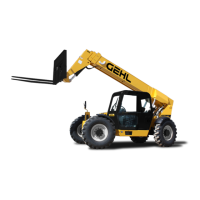PRINTED IN U.S.A. 43 913287/BP0808
SUSPENDED LOADS
DO NOT exceed the Telescopic Handler capacity as
equipped for handling suspended loads. Only lift the
load vertically and NEVER drag it horizontally. Use
tag lines to restrain load swing whenever possible.
The handling of suspended loads by means of the truss
boom or other similar device can introduce dynamic
forces affecting the stability of the machine that are not
considered in the stability criteria of industry test stan-
dards. Grades and sudden starts, stops and turns can
cause the load to swing and create a hazard.
Guidelines for “Free Rigging / Suspended
Loads”
1. The rigging equipment must be in good condition
and comply with U.S. OSHA regulation
1910.184, “Slings,” or 1926.251, “Rigging equip-
ment for material handling.”
2. The rigging equipment must be secured to the
forks such that it cannot slip or slide either side-
ways or fore and aft.
3. The capacity of the fork(s) and the machine
(whichever is less) must not be exceeded.
4. The load center must remain at 24” (610 mm) or
less.
5. No lifting of material may be done when anyone
is on the load, rigging or forks.
6. Multiple pickup points on the load are preferred
to prevent the load from rotating, but a single
pickup point may be used if one or more tag lines
are utilized. And, of course, the load must never
be postioned over personnel at any time.
MATERIAL HANDLING BUCKET TOOL
APPLICATION
IMPORTANT: The 55’ model is not intended for
ground or material pile engagement. The bucket
should be used for light-duty site cleanup only.
Material Densities
The table on this page lists densities for some common
materials that could be carried in a Telescopic Handler
bucket tool. The densities listed are average values and
intended only as a guide.
Table of Common Materials & Densities
Material Density Density
in (lb/yd
3
) in (kg/m
3
)
Ashes 945-1350 560-800
Brick-common 3024 1795
Cement 2970 1760
Charcoal 621 370
Clay 2160-2700 1280-1600
Coal 1431-1701 850-1010
Concrete 3105 1840
Cinders 1350 800
Coal-anthracite 2538 1505
Coke 810 480
Earth-dry loam 810 480
Earth-wet loam 1755 1040
Granite 2511-2997 1490-1780
Gravel-dry 1782 1060
Gravel-wet 2430 1440
Gypsum-crushed 3105 1840
Iron Ore 3915 2320
Lime 1620 960
Limestone 2430 1440
Manure-liquid 1755 1040
Manure-solid 1215 720
Peat-solid 1269 755
Phosphate-granular 2430 1440
Potash 1836 1090
Quartz-granular 2970 1760
Salt-dry 2700 1600
Salt-Rock-solid 3645 2160
Sand-dry 2916 1730
Sand-wet 3375 2000
Sand-foundry 2565 1520
Shale-crushed 2430 1440
Slag-crushed 1890 1120
Snow 405-1350 240-800
Sulpha 2565 1520
Taconite 2889 1715
Digging and Loading
Refer to the illustration on the next page. Retract and
lower the boom, then tilt the bucket’s cutting edge
down into contact with the ground. Drive the bucket
into the material. As the engine loads, roll the bucket
back slowly and, at the same time, decrease travel
speed.
IMPORTANT: ALWAYS fully retract the boom
before driving into material.
NOTE: When attempting to fill the bucket while
working with most hard-packed materials, it will
usually be necessary to raise the boom while
rolling back the bucket.
Courtesy of Crane.Market

